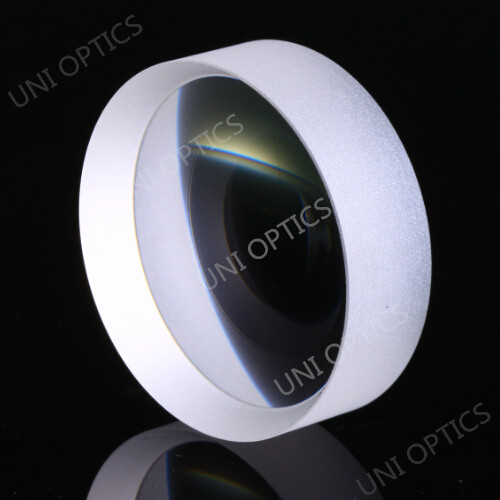双凹透镜是一种带有两个凹面的负焦距的光学透镜,常用于光束扩展、图像缩小或光投影等应用,也是扩大光学系统焦距的理想选择。优恩立公司可为您提供广泛用途的,带有多种涂层的双凹透镜。
产品产地:
中国航运港口:
中国福州交付周期:
四周付款:
银行电汇, 西联付款
1. 什么是双凹透镜?
双凹透镜是一种两面成凹形的透镜,该透镜可为光学系统提供负焦距,因此双凹透镜也称为负透镜或发散透镜。
2.双凹透镜的用途是什么?
双凹透镜通常用于需要扩展光束或增加焦距的应用,如扩束器,投影仪,幻灯机,医学眼科检测…等。
3. 优恩立光学能做什么?
优恩立光学是一家发展迅速,负责任的中国的光学元件和组件制造商,采用多种光学玻璃、熔融石英、晶体和红外材料,借助尖端镀膜技术,我们有能力为您生产出高品质的双凹透镜。广泛的AR膜或V-AR膜层可应用于这些双凹透镜,以提供更高的性能。
参数:


材质:光学玻璃/熔石英
设计波长:546.1nm
直径公差:+0/-0.05mm
焦距公差:+/-2%
表面质量:40-20 S/D
偏心:1 arcmin
面型:n=3△n=0.5
通光孔径:90%
倒角:防护性倒角
镀膜可选:单层氟化镁
多层双面增透膜
入射角: 0°
| Part No. | Material | F(mm) | Φ(mm) | R1=R2(mm) | Tc(mm) | Te(mm) | Fb(mm) |
|---|---|---|---|---|---|---|---|
| ULDV010010 | BK7 | -10.0 | 10.0 | 10.7 | 2.0 | 4.5 | -10.6 |
| ULDV015127 | BK7 | -15.0 | 12.7 | 15.88 | 2.0 | 4.6 | -15.6 |
| ULDV020127 | BK7 | -20.0 | 12.7 | 21.07 | 2.0 | 4.0 | -20.6 |
| ULDV025127 | BK7 | -25.0 | 12.7 | 26.25 | 2.0 | 3.6 | -25.7 |
| ULDV030127 | BK7 | -30.0 | 12.7 | 31.44 | 2.0 | 3.3 | -30.7 |
| ULDV040127 | BK7 | -40.0 | 12.7 | 41.8 | 2.0 | 3.0 | -40.7 |
| ULDV050127 | BK7 | -50.0 | 12.7 | 52.17 | 2.0 | 2.8 | -50.7 |
| ULDV025025 | BK7 | -25.0 | 25.0 | 26.25 | 2.0 | 8.6 | -25.7 |
| ULDV035254 | BK7 | -35.0 | 25.4 | 36.62 | 2.0 | 6.5 | -35.7 |
| ULDV050254 | BK7 | -50.0 | 25.4 | 52.17 | 2.0 | 5.1 | -50.7 |
| ULDV075254 | BK7 | -75.0 | 25.4 | 78.09 | 2.0 | 4.1 | -75.7 |
| ULDV100254 | BK7 | -100.0 | 25.4 | 104 | 2.0 | 3.6 | -100.7 |
| ULDV150254 | BK7 | -150.0 | 25.4 | 155.830 | 2.0 | 3.0 | -150.70 |
| ULDV200254 | BK7 | -200.0 | 25.4 | 207.660 | 2.0 | 2.8 | -200.70 |
| ULDV250254 | BK7 | -250.0 | 25.4 | 259.490 | 2.0 | 2.6 | -250.70 |
| ULDV300254 | BK7 | -300.0 | 25.4 | 311.320 | 2.0 | 2.5 | -300.70 |
| ULDV050038 | BK7 | -50.0 | 38.0 | 52.340 | 3.0 | 10.1 | -51.00 |
| ULDV100038 | BK7 | -100.0 | 38.0 | 104.170 | 3.0 | 6.5 | -101.10 |
| ULDV150038 | BK7 | -150.0 | 38.0 | 156.000 | 3.0 | 5.3 | -151.00 |
| ULDV200038 | BK7 | -200.0 | 38.0 | 207.830 | 3.0 | 4.7 | -201.00 |
| ULDV500038 | BK7 | -500.0 | 38.0 | 518.810 | 3.0 | 3.7 | -501.00 |
| ULDV100050 | BK7 | -100.0 | 50.0 | 104.170 | 3.0 | 9.1 | -101.00 |
| ULDV150050 | BK7 | -150.0 | 50.0 | 156.000 | 3.0 | 7.0 | -151.00 |
| ULDV200050 | BK7 | -200.0 | 50.0 | 207.830 | 3.0 | 6.0 | -201.00 |
| ULDV250050 | BK7 | -250.0 | 50.0 | 259.660 | 3.0 | 5.4 | -251.00 |
| ULDV400050 | BK7 | -400.0 | 50.0 | 415.150 | 3.0 | 4.5 | -401.00 |
| ULDV500050 | BK7 | -500.0 | 50.0 | 518.820 | 3.0 | 4.2 | -501.00 |
| JLDV015127 | JGS1 | -15.0 | 12.7 | 14.110 | 2.0 | 5.0 | -15.70 |
| JLDV020127 | JGS1 | -20.0 | 12.7 | 18.710 | 2.0 | 4.2 | -20.70 |
| JLDV030127 | JGS1 | -30.0 | 12.7 | 27.920 | 2.0 | 3.5 | -30.70 |
| JLDV025254 | JGS1 | -25.0 | 25.4 | 23.320 | 2.0 | 9.5 | -25.70 |
| JLDV050254 | JGS1 | -50.0 | 25.4 | 46.320 | 2.0 | 5.6 | -50.70 |
| JLDV100254 | JGS1 | -100.0 | 25.4 | 92.330 | 2.0 | 3.8 | -100.70 |
| JLDV050038 | JGS1 | -50.0 | 38.0 | 46.480 | 3.0 | 11.1 | -51.00 |
| JLDV100038 | JGS1 | -100.0 | 38.0 | 92.490 | 3.0 | 6.9 | -101.00 |
| JLDV150038 | JGS1 | -150.0 | 38.0 | 138.500 | 3.0 | 5.6 | -151.00 |
| JLDV200038 | JGS1 | -200.0 | 38.0 | 184.500 | 3.0 | 5.0 | -201.00 |
上一个 :
紫外熔融石英平凸透镜下一页 :
MgF2镀膜双凸透镜